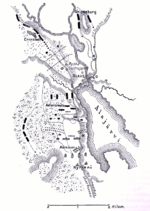
The Finnish War was fought between the Kingdom of Sweden and the Russian Empire from 21 February 1808 to 17 September 1809 as part of the Napoleonic Wars. As a result of the war, the eastern third of Sweden was established as the autonomous Grand Duchy of Finland, a state under the rule of the Russian Empire. Other notable effects were the Swedish parliament's adoption of a new constitution and the establishment of the House of Bernadotte, the new Swedish royal house, in 1818.

The Battle of Ratan was the last battle fought on Swedish soil during the Russian-Swedish War of 1808 - 1809. It took place a day apart from the Battle of Sävar, on 20 August 1809. Having conquered Finland from Sweden, the Russians had a small force in the northern areas of Sweden. The Swedes sought to eliminate this through a combined assault from land and sea, but the Russians moved more rapidly, defeating the Swedish force landed at Ratan at Sävar on 19 August. The next day, on 20 August, the Swedish riflemen was attacked and pushed out of Ratan, turning to the flotilla and starting the evacuation. At the same time, artillery fire from Swedish warships kept the Russians at bay. Peace negotiations followed the heavy fighting.

The Battle of Sävar was fought on Saturday, 19 August 1809, between Swedish and Russian forces, during the Finnish War; it was the last pitched battle to be fought in Sweden. After the Russian conquest of eastern Sweden in 1808, the Swedish forces retreated to actual Sweden. In March the following year, Russian emperor Alexander I launched a threefold attack on Sweden, to force the country into the Continental System and to cede Finland to the Russian Empire; despite early advantages at Kalix and the Åland Islands, the attack failed to achieve a quick ending to the war. After further campaigning in northern Sweden, with battles such as Skellefteå and Hörnefors, the Russian forces under Nikolay Kamensky occupied all of Västerbotten by June.

The Battle of Revolax took place on 27 April 1808 at Revonlahti, in Northern Ostrobothnia, Finland, when the Swedish supreme commander Wilhelm Mauritz Klingspor and the Savolax brigade under Colonel Johan Adam Cronstedt, a total of about 2,250 Swedes surprised an isolated Russian column of about 1,700 men under Major General Michail Leontievich Bulatov. The Russians were surrounded and tried to cut their way through but failed and the Russian general Bulatov was taken prisoner by the Swedes.

The Battle of Oravais from September 14 until September 15 was one of the decisive battles in the Finnish War, fought from 1808 to 1809 between Sweden and the Russian Empire as part of the wider Napoleonic Wars. Taking place in modern-day Vörå in western Finland, it is sometimes regarded as the turning point of the Finnish War: the last chance for Sweden to turn the war to her advantage. It was the bloodiest battle of the conflict, along with the Battle of Sävar, which some historians attribute to the exhaustion, resignation and desperation of the Swedish army: it was losing the war, and defeat led to its loss of Finland to Russia.

The Battle of Siikajoki was fought between Swedish and Russian troops on 18 April 1808 at Siikajoki, approximately 60 km south of Uleåborg, Swedish Finland. During the first stage of the Finnish War, the Swedish commander Wilhelm Mauritz Klingspor had decided to retreat from southern Finland, so that the Swedes would gain time, and more troops could be moved to Finland via Tornio. The retreat was also made in an effort to delay battles until the seas thawed, and to reserve troops in case the Danes took the opportunity to attack Sweden.

Count Wilhelm Mauritz Klingspor was a Swedish noble military officer and one of the Lords of the Realm. He is probably best known from his time as field marshal of Finland during the Finnish War, where his command of the Swedish army contributed to the Swedish loss. He is also known for participating in the coup of 1809 that dethroned Gustav IV of Sweden.
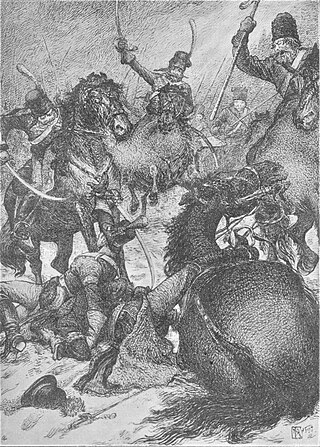
The Battle of Pyhäjoki was a retreating action fought on 16 April 1808, at Pyhäjoki in Northern Ostrobothnia during the Russian–Swedish war of 1808–09. The winter made the operations more difficult and the battle of Pyhäjoki became one of the first skirmishes to be fought after the Swedish retreat stopped. The Russian army had been following the Swedish army to the north. At the same time, they had left large portions of Finland to be occupied by the Russians. Yakov Petrovich Kulnev led a vanguard of 1,300 men — his army counted 4,000 men in total — and caught up with the rearguard of the retreating Swedish main army at the village of Ypperi. Skirmishes occurred all the way to Pyhäjoki, where the Swedes made a brief stand, before Wilhelm Mauritz Klingspor gave orders to von Döbeln and Gripenberg to continue the retreat to follow the original strategic plan. The Swedes had checked Kulnev's attack with about 2,000–2,500 men, however, as the Swedes fought a retreating battle, only one battalion at the time could go up against the Russians for most of the fighting. They had lost 183 men in killed, wounded and captured. Kulnev had lost 71 men at Pyhäjoki alone but probably around double that number when applying the losses from the fighting at Ypperi towards Pyhäjoki.

The Battle of Nykarleby was fought between Sweden and the Russian Empire during the Finnish War of 1808–1809.
The Battle of Vaasa was fought between the Kingdom of Sweden and the Russian Empire during the Finnish War (1808-1809).

The Helsinki village landing, or the Combat of Helsinge, was fought during the Finnish War between Sweden and the Russian Empire on 26–28 September 1808, a part of the battles of the Turku archipelago.
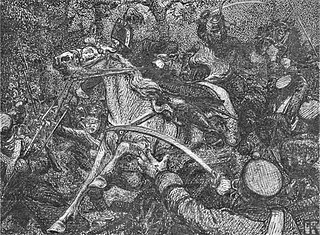
The battle of Ruona–Salmi or the battle of Kuortane was fought between Swedish and Russian troops on 1–2 September 1808 at Ruona and Salmi, Kuortane. The Swedish army was led by Wilhelm Mauritz Klingspor with 4,700, 5,000, or 5,500 men under his command against the Russian army of between 9,000 and 11,000 men under the command of Nikolay Kamensky. The battle turned up to be a major engagement in the war where fierce artillery fire occurred from both sides. Kamensky, advancing from Alanus, beat back the Swedish barriers and on 31 August approached the Swedish army's position near Kuortane.
The Battle of Lintulaks was fought between Swedish and Russian forces at Lintulaks in Finland on 3 July 1808 during the Finnish War.

The Battle of Kokonsaari was fought between Swedish and Russian forces at Kokonsaari in Finland on 11 July 1808 during the Finnish War.

The Battle of Nummijärvi was fought between Swedish and Russian forces at Nummijärvi in Finland on 28 August 1808 during the Finnish War.
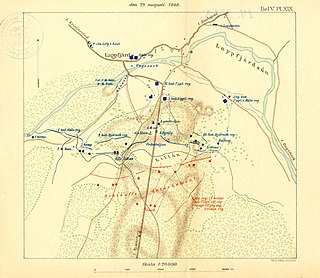
The Battle of Lappfjärd was fought between Swedish and Russian forces at Lappfjärd in Finland on 29 August 1808 during the Finnish War.

The Åland Offensive was part of a threefold attack on native Sweden by the Russian Empire during the Finnish War, to force Sweden into the Continental System and to give up Finland. Åland was to be used for an immediate attack on Stockholm. Only minor skirmishes occurred when Gotthard Johann von Knorring launched his Åland offensive on 10 March 1809, since the Swedes under Georg Carl von Döbeln quickly withdrew over the ice to Stockholm. Although suffering heavy casualties, the Swedish army had escaped destruction. The concluding Convention of Åland not only brought an end to the Russian offensive, but led to their withdrawal from the islands.

The Capitulation of Kalix took place during the Finnish War, on 25 March 1809, when 3,800–4,500 Swedish and Finnish troops under Hans Henrik Gripenberg surrendered to a much larger Russian army under Pavel Andreyevich Shuvalov, as part of a large Russian threefold attack against Sweden. The capitulation was characterised by the Swedish High Command as treacherous and Gripenberg was soon court-martialed.

The Battle of Skellefteå took place during the Finnish War, on 15 May 1809, when 6,000 Russians under Pavel Andreyevich Shuvalov attacked 700 Swedes under Johan Henrik Furumark, at Skellefteå, Sweden. The Swedes, who fought a delaying action to buy time for their provisions to be escorted to safety, were captured as the Russians flanked around and cut-off their way of retreat. Most provisions, however, were saved.
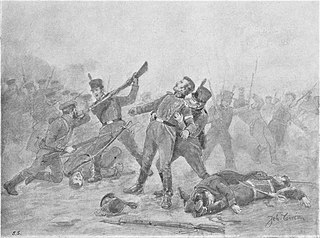
The Battle of Hörnefors took place during the Finnish War, on 5 July 1809, when 2,400 Swedes under Johan August Sandels went on a counter-offensive against 3,350 Russians under Ilya Alekseyev and Pavel Andreyevich Shuvalov, at Hörnefors, Sweden. After more than two hours of intense fighting along the Hörnån (river) Sandels ordered a retreat, after having been misinformed of a greater Russian flanking attack.

